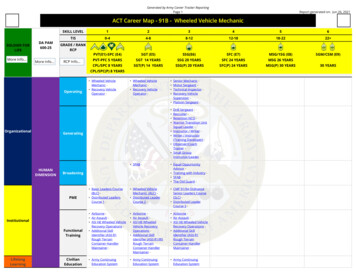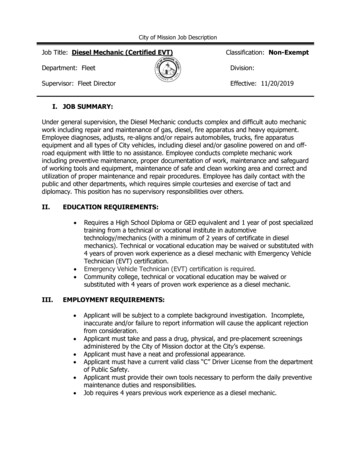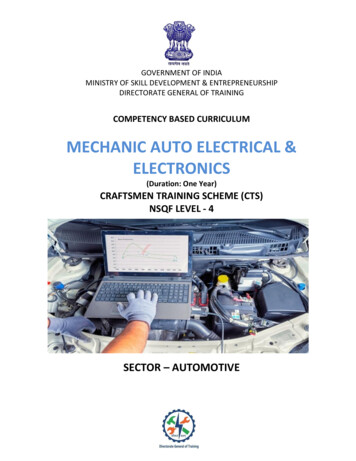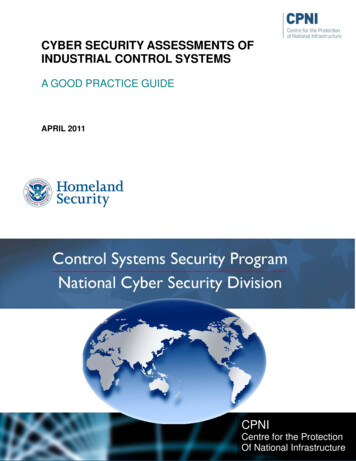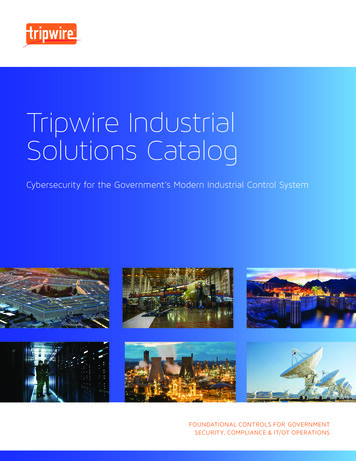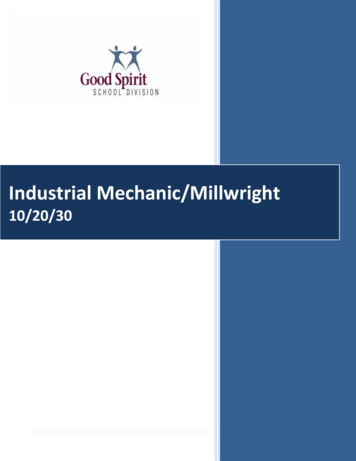
Transcription
Industrial Mechanic/Millwright10/20/300 P a g e
AcknowledgementsBob HaackeChurchbridge Community Council MemberInterprovincial Journeyman Millwright/ Industrial MechanicMillwright/ Industrial Mechanic Program Initiatorand DeveloperWarren KaedingChurchbridge Community Council Vice ChairMillwright/ Industrial Mechanic Program Initiator andDeveloperBill StauchChurchbridge Community Council ChairKristen GroeneveldChurchbridge Community Council SecretaryHolly ChylaChurchbridge Community Council TreasurerLori MorashChurchbridge Community Council MemberClayton HendersonChurchbridge Community Council MemberDale FraserChurchbridge Community Council MemberMrs. Pam WerleChurchbridge Community Council Teacher MemberLois SmadychChurchbridge Community CouncilDivision Board MemberWithman JaigobinSuperintendent of SchoolsGood Spirit School DivisionAlan SharpSuperintendent of CurriculumGood Spirit School DivisionAlisa LeidlChurchbridge Community Council MemberSchool PrincipalAll of our Donors and Sponsors
Table of ContentsIntroduction . . iIntroduction to the Trade . iiPurpose and Areas of Focus Level 10 . 1Purpose and Areas of Focus Level 20 . 2Purpose and Areas of Focus Level 30 . . 3Module: 001A Safety . . 4Module: 002A Electricity . . 5Module: 003A Measurement & Layout 6Module: 004A Hand tools & Power Tools 7Module: 005A Rigging . 8Module: 006A Fasteners . . 9Module: 007A Metallurgy . 10Module: 008A Bearings & Seals . 11Module: 010A Oxy-Acetylene Welding . 12Module: 015A Trade Math . . 13Module: 017A Applied Blueprint Reading . . 14Module: 018A Saskatchewan Youth Apprenticeship . . 15Assessment and Evaluation of Student Learning . 16References . . 16List of Resource Materials . . 18PAA Online Resources . 19i
IntroductionThis curriculum was developed in response to a community need identified by the Churchbridge Public School-Community Council. The groupbelieved that an Industrial Arts program geared towards the industrial trades would benefit students and employers.This program could provide the students with the essential work experience, life skills and academic development in full and part-time tradeswhich promote life-long learning opportunities which respond to the needs of the adult population, communities, organizations and employersin the ever changing environment of our region. The Saskatchewan Youth Apprenticeship program would be implemented and would readystudents for the Apprenticeship programs offered at Parkland College in Esterhazy and the SIAST Industrial Mechanic Apprenticeship Program inSaskatoon where this would count towards hours logged in the apprenticeship program and bring the students closer to receiving theirJourneyman status.Major stakeholders in the program would be the Ministry of Education, GSSD, SIAST, Saskatchewan Apprenticeship and Trade CertificationCommission, local employers such as: Mosaic Potash, Potash Corp of Saskatchewan, Louis Dreyfus, EMW Industrial, plus many local mechanicalcontractors.The Industrial Mechanic/ Millwright 10 curriculum is designed with modules to complete one, 100 hour pure course. It is our intent to furtherdevelop 20 and 30 level courses.ii
Industrial Mechanic / MillwrightIndustrial Mechanics/Millwrights install, repair and maintain machinery that is used in factories, mines and production facilities.What do Industrial Mechanics (Millwrights) do? Read blueprints, diagrams and schematic drawings to determine work procedures.Install, align, dismantle and move stationary industrial machinery and mechanical equipment according to layout plans usinghand and power tools.Operate hoisting and lifting devices during installation, set-up and repair of machinery.Adjust machinery and repair or replace defective parts.Essential skills for success as an Industrial Mechanic/MillwrightReading Read notes from co-workers, such as descriptions of work completed. Read directions on product labels for safe handling, usage and first aid procedures. Read memos and notices from supervisors, co-workers and suppliers, such as notices about scheduled power shutdowns. Read bulletins from regulatory organizations about changes to standards, regulations and code requirements. Read manuals for operating, troubleshooting and repairing tools and equipmentDocument Use Look for caution and warning signs to identify hazards in work areas. Scan labels for information, such as part, model and serial numbers. Locate data in lists, tables and schedules, such as to find out what tools and parts are needed to assemble machinery. Fill in forms, such as purchase orders. Interpret schematic drawings. Retrieve data from scale drawings, such as to identify the locations of machinery to be installed and serviced.iii
Numeracy Measure using rulers, tapes, thermometers and scales. Compare measurements such as width, height, temperature, pressure and rotations per minute on a variety of parts andspecifications to make sure they are within an acceptable range. Estimate time required to complete installation and repair tasks. Adjust and align machinery and equipment according to specifications. Use specialized measuring tools such as vernier callipers, micrometers, angle finders, feeler gauges and dial indicators. Calculate loads, capacities and dimensions for mechanical components and systems.Writing Write brief text entries in forms and logbooks, such as observations of equipment performance. Write incident reports in forms that describe malfunctions, breakdowns and accidents that identify potential causes andeffects. Write maintenance and repair procedures.Oral communication Talk to suppliers and contractors about equipment specifications, deliveries, service times and price quotes. Discuss work orders, equipment malfunctions and job task coordination with co-workers. Communicate with supervisors about work progress and seek their guidance and approvals. Discuss issues such as safety, productivity, major repairs and policy changes at meetings with co-workers, supervisors,engineers and clients. Teach practices and procedures to co-workers, apprentices and clients.iv
Working with others Work independently. Form teams with co-workers, clients and contractors when installing and overhauling large pieces of equipment orcompleting industrial systems. Participate in discussions about work processes or product improvement. Demonstrate how to perform tasks to other workers. Orient or train new employees. Monitor the work performance of others.Thinking Determine whether to refurbish, repair or replace worn and defective parts. Assess whether designs meet technical specifications, performance requirements and regulations. Plan job tasks based on work assignments and follow planned work schedules to coordinate work with co-workers andcontractors. Take necessary steps when parts needed for maintenance and repairs are unavailable, such as fabricating replacementparts or obtaining approvals to use non-standard parts. Select materials and methods to maintain, repair and improve industrial equipment and systems. Evaluate the safety of work environments. Use a number of sources to find technical information needed to troubleshoot faults with machinery and systemsComputer use Use databases, such as maintenance and financial systems databases. Use computer-assisted design, manufacturing and machining programs. Use email to communicate with supervisors, clients and suppliers. Use handheld devices such as vibration data collectors and analyzersv
Continuous learning Read manuals and bulletins to stay aware of new developments in the industry. Learn informally by exchanging information with co-workers and suppliers. Attend training workshops on new equipment and safety procedures. Take courses to learn and improve technical skills.References:Human Resources and Skills Development Canada/Essential skillsSaskatchewan Apprenticeship and Trade Certification Commissionvi
Purpose and Areas of Focus Level 10ModulesNameModule 001AModule 002AModule 003ASafety 10Electrical 10Measurement & Layout 10Module 004AHand & Power tools 10Module 005AModule 006AModule 007AModule 008AModule 010ASuggested hoursShop hours545651057Rigging 10Fasteners 10Metallurgy 10Bearings & Seals 10Oxy-Acetylene welding 105-105551055551089101112Module 015AModule 017ATrade Math 10Blueprint Reading 105-105-101314Module 018Saskatchewan Youth ApprenticeshipStudent’s time15Total hours52-3Page62-78Min 100 theory andshop time401
Purpose and Areas of Focus Level 20ModulesModule 001BModule 002BModule 003BNameSafety 20Electrical 20Measurement & Layout 20Suggested hoursShop hours52-3Page516171855519Module 004BAbrasives & Grinders 20Module 005BModule 007BModule 008BModule 009BRigging 20Metallurgy 20Bearings & Seals 20Belt & Chain Drive 205-10555555520212223Module 010BElectric arc welding 20101024Module 012BModule 015BModule 016BMetal LatheTrade Math 20Workplace Communication 2055-105-105252627Module 017BBlueprint Reading 205-1028Module 018Saskatchewan Youth ApprenticeshipStudent’s time29Total hours67-88Min 100 theory andshop time452
Purpose and Areas of Focus Level 30ModulesModule 001CModule 002CModule 003CNameSafety 30Electrical 30Measurement & Layout 30Suggested hoursShop hours152-5Page3031325533Module 004CModule 005CModule 008CDrills & Drilling 30Rigging 30Bearings, Seals & Lubrication 3055-1055553435Module 009CGear Drives & Couplings 305-10536Module 013CModule 014CMilling MachineMachinery Installation 305-105553738Module 015CModule 017CTrade Math 30Blueprint Reading 305-105-103940Module 018Saskatchewan Youth ApprenticeshipStudent’s time41Total hours62-90Min 100 theory andshop time353
Module: 001 ASuggested time: 5SafetyLevel: 10Outcomes:Indicators:Prerequisite:Apply principles and techniquesfor unintentional injury preventionto ensure safe work performancein all work areas.a. Identify the purpose and demonstrate the proper use and fitof personal protective equipment (PPE) including eye protection(lens shades), clothing, hearing protection, and footwear whileidentifying the hazards from which they protect individuals.Noneb. Analyze potential risk situations and solutions that applyspecifically to slips, trips and falls, as well as lifting heavymaterial, and identify safe solutions. Proper housekeeping andcorrect lifting procedures.c. Recognize hazards associated with the Industrial Mechanictrade (hand tools, power tools, equipment and electricity) andtake the necessary measures to avoid unintentional injuries.d. Demonstrate the proper procedures to follow when reportingan unintentional injury.Work safely with properlymaintained safety equipment in an a. Express knowledge of safe handling of materials according toWHMIS, using materials safety data sheets (MSDS).organized environment.b. Research and discuss Occupational Health and Safetyregulations which apply to the Industrial Mechanical trade.c. Recognize and apply safe and fair work practices includingfreedom from violence and harassment.d. Complete an assessment of all tools and welding equipment.4
Module: 002 ASuggested time: 2-3ElectricityLevel: 10Outcomes:Indicators:Prerequisite:Provide the Industrial Mechanicwith enough electrical knowledgeso that safe decisions may bemade when working on or aroundelectrical equipment.a. Describe the basic principles of electricityNoneb. Identify potential electrical equipment hazardsc. Identify safety problems and discuss with Instructor, Teacherways of correcting safety hazards.5
Module: 003 ASuggested time: 5Measurement & LayoutLevel: 10Outcomes:Indicators:Prerequisite:Describe the use of measuringtools for the millwright tradea. Identify basic measuring tools used in the millwright tradeb. Describe metric and imperial comparison and conversionmeasurements.NoneDescribe & demonstrate layoutprocedures, understand thepurpose and safe handling of eachlayout tool.a. Identify the tools used for layout procedures.b. Explain layout purpose and procedures.c. Demonstrate uses of layout tools in shop projects.d. Prepare metal for layout with layout dye.d. The student will be able to accurately layout and safely handlelayout tools.Describe & demonstrate uses ofnon-cutting hand tools.a. Identify & name common tools used for performing non-cuttingbench-work procedures.b. Describe & demonstrate methods used in the workshop forcleaning Handtools. (non-cutting).Describe & demonstrate thecorrect use
Identify basic measuring tools used in the millwright trade b. Describe metric and imperial comparison and conversion measurements. a. Identify the tools used for layout procedures. b. Explain layout purpose and procedures. c. Demonstrate uses of layout tools in shop projects. d. Prepare metal for layout with layout dye. d. The student will be able to accurately layout and safely handle layout .
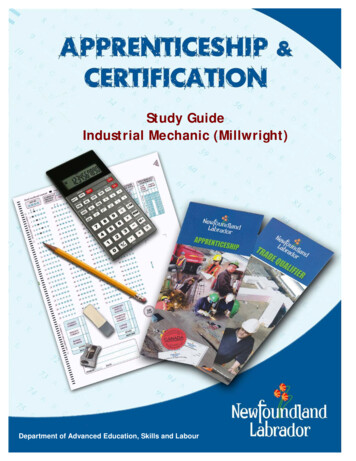
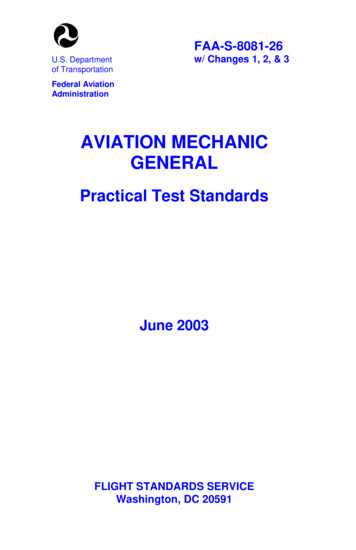
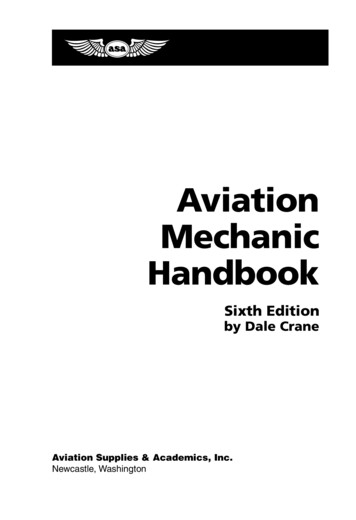
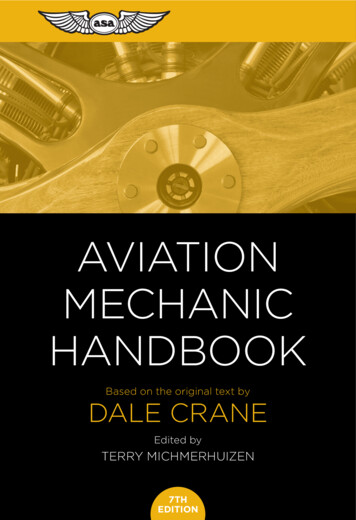

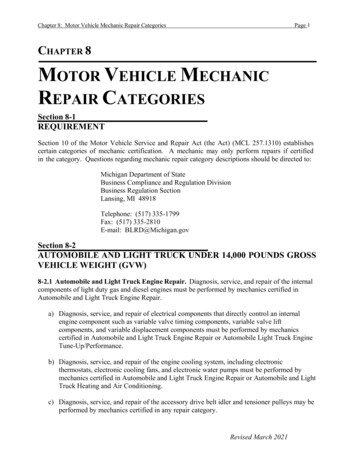
![Motorcycle Mechanic [MM] - CTEVT](/img/5/motorcycle-20-20mechanic-2010.jpg)
